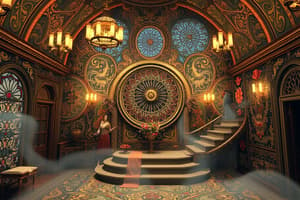Podcast
Questions and Answers
What is the characteristic of uniform acceleration?
What is the characteristic of uniform acceleration?
- The velocity is zero
- The acceleration is constant (correct)
- The acceleration changes with time
- The displacement is zero
What does the slope of a distance-time graph represent?
What does the slope of a distance-time graph represent?
- Velocity (correct)
- Acceleration
- Displacement
- Time
What is the equation of motion that relates velocity, acceleration, and time?
What is the equation of motion that relates velocity, acceleration, and time?
- v = u + at (correct)
- s = ut + (1/2)at^2
- a = Δv / Δt
- v^2 = u^2 + 2as
What does the area under a velocity-time graph represent?
What does the area under a velocity-time graph represent?
What type of motion occurs when two objects move in a circular path?
What type of motion occurs when two objects move in a circular path?
What is the velocity of one object relative to another object or a frame of reference?
What is the velocity of one object relative to another object or a frame of reference?
What does a curved line indicate on a distance-time graph?
What does a curved line indicate on a distance-time graph?
What is the equation of motion that relates displacement, initial velocity, acceleration, and time?
What is the equation of motion that relates displacement, initial velocity, acceleration, and time?
What does a straight line indicate on a velocity-time graph?
What does a straight line indicate on a velocity-time graph?
What is the acceleration of one object relative to another object or a frame of reference?
What is the acceleration of one object relative to another object or a frame of reference?
Flashcards are hidden until you start studying
Study Notes
Uniform Acceleration
- Uniform acceleration occurs when an object's velocity changes at a constant rate.
- The acceleration of an object is uniform if it travels equal distances in equal times.
- The acceleration is constant, meaning it does not change with time.
Graphical Representation
- Distance-Time Graphs:
- A straight line indicates uniform motion.
- A curved line indicates non-uniform motion.
- The slope of the line represents the velocity.
- Velocity-Time Graphs:
- A straight line indicates uniform acceleration.
- A curved line indicates non-uniform acceleration.
- The slope of the line represents the acceleration.
- The area under the curve represents the displacement.
Equations of Motion
- First Equation of Motion:
- v = u + at
- where v is the final velocity, u is the initial velocity, a is the acceleration, and t is the time.
- Second Equation of Motion:
- s = ut + (1/2)at^2
- where s is the displacement, u is the initial velocity, a is the acceleration, and t is the time.
- Third Equation of Motion:
- v^2 = u^2 + 2as
- where v is the final velocity, u is the initial velocity, a is the acceleration, and s is the displacement.
Relative Motion
- Relative Motion: The motion of an object relative to another object or a frame of reference.
- Types of Relative Motion:
- Translational Motion: When two objects move in the same direction.
- Rotational Motion: When two objects move in a circular path.
- Relative Velocity: The velocity of one object relative to another object or a frame of reference.
- Relative Acceleration: The acceleration of one object relative to another object or a frame of reference.
Uniform Acceleration
- Uniform acceleration occurs when an object's velocity changes at a constant rate.
- The acceleration of an object is uniform if it travels equal distances in equal times.
- The acceleration is constant, meaning it does not change with time.
Graphical Representation
- Distance-time graphs show uniform motion with a straight line and non-uniform motion with a curved line.
- The slope of the distance-time graph represents the velocity.
- Velocity-time graphs show uniform acceleration with a straight line and non-uniform acceleration with a curved line.
- The slope of the velocity-time graph represents the acceleration.
- The area under the velocity-time graph represents the displacement.
Equations of Motion
- The first equation of motion is v = u + at, where v is the final velocity, u is the initial velocity, a is the acceleration, and t is the time.
- The second equation of motion is s = ut + (1/2)at^2, where s is the displacement, u is the initial velocity, a is the acceleration, and t is the time.
- The third equation of motion is v^2 = u^2 + 2as, where v is the final velocity, u is the initial velocity, a is the acceleration, and s is the displacement.
Relative Motion
- Relative motion is the motion of an object relative to another object or a frame of reference.
- Translational motion occurs when two objects move in the same direction.
- Rotational motion occurs when two objects move in a circular path.
- Relative velocity is the velocity of one object relative to another object or a frame of reference.
- Relative acceleration is the acceleration of one object relative to another object or a frame of reference.
Studying That Suits You
Use AI to generate personalized quizzes and flashcards to suit your learning preferences.




